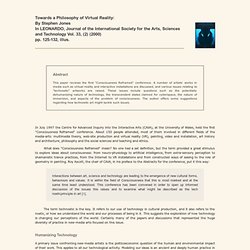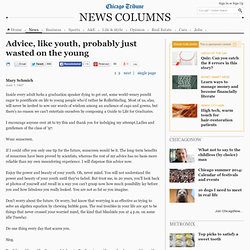

How to Build a Universe That Doesn't Fall Apart Two Days Later. First, before I begin to bore you with the usual sort of things science fiction writers say in speeches, let me bring you official greetings from Disneyland. I consider myself a spokesperson for Disneyland because I live just a few miles from it—and, as if that were not enough, I once had the honor of being interviewed there by Paris TV.
For several weeks after the interview, I was really ill and confined to bed. Stephen Jones (2000). Towards a Philosophy of Virtual Reality: Issues Implicit in "Consciousness Reframed". Abstract This paper reviews the first "Consciousness Reframed" conference.

A number of artists' works in media such as virtual reality and interactive installations are discussed, and various issues relating to "technoetic" artworks are raised. These issues include questions such as the potentially dehumanizing nature of technology, the transcendent states claimed for cyberspace, the nature of immersion, and aspects of the problem of consciousness. The author offers some suggestions regarding how technoetic art might tackle such issues. In July 1997 the Centre for Advanced Inquiry into the Interactive Arts (CAiiA), at the University of Wales, held the first "Consciousness Reframed" conference. What does "Consciousness Reframed" mean? Interactions between art, science and technology are leading to the emergence of new cultural forms, behaviours and values.
The term technoetic is the key. Norse Mythology. Project Gutenberg - free ebooks. Advice, like youth, probably just wasted on the young. Inside every adult lurks a graduation speaker dying to get out, some world-weary pundit eager to pontificate on life to young people who'd rather be Rollerblading.

Most of us, alas, will never be invited to sow our words of wisdom among an audience of caps and gowns, but there's no reason we can't entertain ourselves by composing a Guide to Life for Graduates. I encourage anyone over 26 to try this and thank you for indulging my attempt.Ladies and gentlemen of the class of '97: Wear sunscreen. If I could offer you only one tip for the future, sunscreen would be it.
The long-term benefits of sunscreen have been proved by scientists, whereas the rest of my advice has no basis more reliable than my own meandering experience. Enjoy the power and beauty of your youth. Don't worry about the future. The H. P. Lovecraft Historical Society. Cuentos de H.P. Lovecraft. The Humor Archive (CCT) These files have been collected off of the superhypeway/supersoaker over the last decade. Unfortunately, I do not have the origins of all these entries. Please let me know if you have any information on where they originated.
Also, if there are works that are copyrighted and should not be in here, let me know, and I will remove them. I did not write any of the stuff in this section of my homepage. (Although I did compile the professor quotes.) "Got to break free from my current struggles and place more humorous articles in here. What is the relationship between Dr. John Dee and the Necronomicon? The Necronomicon is the rarest and most terrible of the magical grimoires.
According to New England horror writer Howard Philip Lovecraft, the Necronomicon was "Composed by Abdul Al-Hazred, a mad poet of Sanaa, in Yemen, who is said to have flourished during the period of the Ommiade caliphs, circa 700 A.D. He visited the ruins of Babylon and the subterranean secrets of Memphis and spent ten years alone in the great southern desert of Arabia - the Roba al Khaliyeh, or "Empty Space" of the ancients and "Dahma" or "Crimson" desert of the modern Arabs, which is held to be inhabited by protective evil spirits and monsters of death. Of this desert many strange and unbelievable marvels are told by those who pretend to have penetrated it. In his last years, Al-Hazred dwelt in Damascus, where the Necronomicon (Al Azif) was written, and of his final death or disappearance (738 A.D.) many terrible and conflicting things are told.
" This is not an implausible suggestion. Introduction. Daniel Chandler Introduction If you go into a bookshop and ask them where to find a book on semiotics you are likely to meet with a blank look. Even worse, you might be asked to define what semiotics is - which would be a bit tricky if you were looking for a beginner's guide. It's worse still if you do know a bit about semiotics, because it can be hard to offer a simple definition which is of much use in the bookshop. If you've ever been in such a situation, you'll probably agree that it's wise not to ask. Assuming that you are not one of those annoying people who keeps everyone waiting with your awkward question, if you are searching for books on semiotics you could do worse than by starting off in the section. Thus wrote the Swiss linguist Ferdinand de Saussure (1857-1913), a founder not only of linguistics but also of what is now more usually referred to as semiotics (in his , 1916).